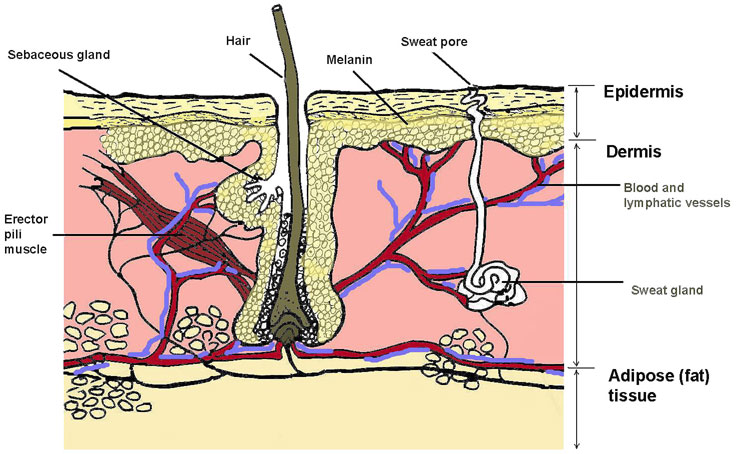What are the names and functions of the two main layers of the skin?
Test your knowledge about the skin by answering the following questions. If you get stuck on any of them, you'll find the answers in the article below.
1. The outer layer of the skin is called the ____________.
2. The inner layer of the skin is called the ____________.
3. Melanin is produced in the top sub-layer of the epidermis by ______________.
4. The stratum corneum is the _________ layer of the epidermis.
5. The epidermis includes ________ sub-layers.
6. Nerve endings are contained within the __________.
What are the names and functions of the two main layers of the skin?
The epidermis - The epidermis is the outer layer of the skin and is formed of five sub-layers. From outer to inner, the layers are named the stratum corneum, stratum licidum, stratum granulosum, stratum spinosum, and stratum germinativum (or stratum basale). The stratum germinativum is where cells divide and push already formed cells into higher layers. As the cells move into the higher layers they eventually die, and the top layer of the epidermis, the stratum corneum, is made of dead, flat skin cells that shed about every 4 weeks. This layer contains melanocytes, which produce melanin (the pigment which colours the skin and protects it from ultraviolet radiation), and also Langerhan's cells, which are part of the body's immune system. It also contains tiny openings (pores) that allow sweat ducts and hair follicles to push through from the dermis below.
The dermis - The dermis is the inner layer of the skin, lying above the subcutaneous fat layer. Formed in two layers, the papillary (thin) and the reticular (thicker and tougher), it is formed mainly from areolar tissue, white collagen fibres and elastin, and is a tough yet stretchable tissue able to allow growth. It contains nerve endings and cells (which act as sensory receptors to pain, itch, temperature, touch and pressure), sweat glands (which produce sweat to help regulate body temperature), sebaceous glands (which produce sebum, an oily substance that helps keep the skin from drying out and keeps the hair soft, and also combines with sweat to form an anti-fungal and antibacterial layer on the skin), hair follicles (the sites of hair growth), and a fine network of blood and lymphatic vessels (responsible for an exchange of oxygen, nutrients and waste products).

The anatomy of the skin
Reference : Human Physiology - Silverthorn (Amazon link)
Resources :
In this section we've added a few alternative study aids to help you along.
- Articles - Here you'll find a range of short articles on basic anatomy and physiology topics, complete with a few 'test yourself' questions for each one.
- Images and pdf's - Just in case you get tired of looking at the screen we've provided images and pdf files that you can print out and use for 'off-line' practice.
- Word Roots - When you learn the word roots, prefixes and suffixes contained within anatomical and medical terms, you can often work out what they mean. This can be a useful skill as you progress in your studies, so we've provided a dictionary to help you!
- Games - Finally in the resources section, we've added some simple games to make anatomy and physiology practice a little bit more fun.



